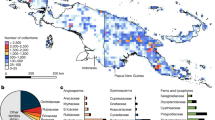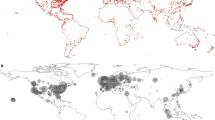Abstract
Monographs provide fundamental data critical to making informed conservation decisions. Do modern monographs, however, contribute to our knowledge of the diversity of the Neotropical flora or has most of the enumeration of species already been accomplished in older monographs, floristic treatments, and other research? How well monographed is the Neotropical flora and what is the approximate number of Neotropical plant species new to science that await description? Authors of 76 recent monographs of the Neotropical flora recognized a total of 8711 species, of which 2487 (29%) were new species described by the author of the monograph during the course of the research. The number of species of flowering plants new to science remaining to be described is estimated to be ca. 22000, or about 25 percent of the total flora. These estimates show the critical importance of the contributions of monographers to an accurate and complete inventory of Neotropical plant diversity.
Similar content being viewed by others
References
Cavalcanti RB (ed) (1995) Prioridades para Conservação da Mata Atlântica do Nordeste (mapa). Workshop, Mata Atlântica do Nordeste, Ilha de Itamaracá, Pernambuco, 6–10 December, 1993. Conservation International, Washington, DC
Conservation International (1991)Workshop 90: Biological Priorities for Conservation in Amazonia. Map. Conservation International, Washington, DC
Convention on Biological Diversity (1994) Convention on Biological Diversity, Text and Preamble. UNEP, Geneva
Cracraft J (1995) The urgency of building global capacity for biodiversity science. Biodiversity and Conservation 4: 463–475
Forero E and Mori S (1995) The organization for Flora Neotropica. Brittonia 47: 379–393
Frodin DG (1984) Guide to Standard Floras of the World. Cambridge University Press, Cambridge, UK
Gentry AH (1993) A Field Guide to the Families and Genera ofWoody Plants of Northwest South America. Conservation International, Washington, DC
Huston MA (1994) Biological Diversity: The Coexistence of Species on Changing Landscapes. Cambridge University Press, Cambridge, UK
Longman KA and Jeník J (1987) Tropical Forest and its Environment, 2nd ed. Longman Scientific and Technical, Essex, UK; John Wiley, New York
Maas PJM and Westra LYT (1993) Neotropical Plant Families. Koeltz Scientific Books, Koenigstein, Germany
Maas PJM and Westra LYT (1998) Familias de Plantas Neotropicales. Koeltz Scientific Books, Koenigstein, Germany
McNeely J, Miller K, Reid W, Mittermeier R and Werner T (1990) Conserving the World's Biological Diversity. IUCN, Gland
Mori S (1992) Neotropical floristics: Who will do the work? Brittonia 44: 372–375
Olson D, Dinerstein E, Castro G and Maravi E (eds) (1996) Identifying Gaps in Botanical Information for Biodiversity Conservation in Latin America and the Caribbean. World Wildlife Fund, Washington, DC
Prance GT (1977) Floristic inventory of the Tropics: where do we stand? Annals of the Missouri Botanical Garden 64: 659–684
Prance GT (1985) Monographing in the 1980s. Aliso 11: 231–242
Prance GT (1994) A comparison of the efficacy of higher taxa and species numbers in the assessment of biodiversity in the Neotropics. Philosophical Transactions of the Royal Society of London, Series B: Biological Sciences 345: 89–99
Prance GT (1995) Systematics, conservation, and sustainable development. Biodiversity and Conservation 4: 490–500
Raven PH (1988) Tropical floristics tomorrow. Taxon 37: 549–560
Smith LB and Downs RJ (1974) Pitcairnioideae (Bromeliaceae). Flora Neotropica 14(1): 1–658
Smith LB and Downs RJ (1977) Tillandsioideae (Bromeliaceae). Flora Neotropica 14(2): 663–1492
Smith LB and Downs RJ (1979) Bromelioideae (Bromeliaceae). Flora Neotropica 14(3): 1493–2142
Systematics Agenda 2000 (1994) Systematics Agenda 2000: Charting the biosphere. A global initiative to discover, describe, and classify the world's biodiversity. SA2000: A Consortium of the American Society of Plant Taxonomists, the Society of Systematic Biologists, and the Willi Hennig Society, in cooperation with the Association of Systematics Collections
Wetterberg GB, Pádua J, Castro CS de and Vasconcellos JMC de (1976) Uma análise de prioridades em conservação da natureza na Amazônia. PNUD/FAO/IBDF/BRA 45. Série Técnica No. 8: 1–62
World Conservation Monitoring Centre (1992) Global Biodiversity: Status of the Earth's Living Resources. Chapman & Hall, London
Author information
Authors and Affiliations
Rights and permissions
About this article
Cite this article
Thomas, W.W. Conservation and monographic research on the flora of Tropical America. Biodiversity and Conservation 8, 1007–1015 (1999). https://doi.org/10.1023/A:1008857429787
Issue Date:
DOI: https://doi.org/10.1023/A:1008857429787




